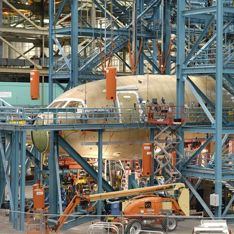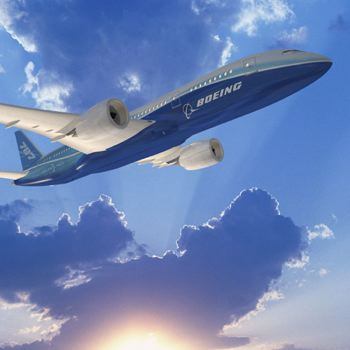 The Boeing Dreamliner has been almost a decade in the making, but will it be a game changer? Contributing writer David DeVoss explores the 787’s new developments and reviews everything from cosmetic lighting effects to luxury amenities like bidets to real manufacturing innovations.
The Boeing Dreamliner has been almost a decade in the making, but will it be a game changer? Contributing writer David DeVoss explores the 787’s new developments and reviews everything from cosmetic lighting effects to luxury amenities like bidets to real manufacturing innovations.
Later this month, on October 26, the world’s most modern airplane, the Boeing 787 Dreamliner, will take off from Tokyo’s Narita airport for a 4.5-hour flight to Hong Kong. Passengers aboard the All Nippon Airways flight will arrive at the same time and pay close to the same fare they would have if they had flown on a 747. But the aviation industry is betting, praying actually, that passengers will find the Dreamliner experience transcendent.
The Dreamliner is much smaller than the 777, the last totally redesigned aircraft Boeing introduced in 1995. The midsized widebody 787 holds 210 to 290 passengers depending on the configuration, but it’s no metal tube. Passengers in all three service classes will have more room, better air quality, higher humidity and soft natural light thanks to large 19-inch windows that filter the amount of outside light with the touch of a button. The overhead luggage bins are larger and a vaulted 8-ft. tall cathedral ceiling makes the 17-ft. wide cabin feel spacious. But the real game changer is the plane’s interior lighting. Gone is the fluorescent glare that makes most airframes feel claustrophobic. In its place is a “sky blue” lighting system with LED controls that can be adjusted to approximate different times of the day.
Lighting is critical to the new plane’s atmospherics. Boeing engineers discovered that slight adjustments in the shade and strength of light could influence a passenger’s mood, body temperature and sense of well being. Lighting also can enhance the appearance of food, making steak look fresh.
An airplane costing $200 million with a range of up to 8,200 nautical miles ought to have plenty of amenities and passengers aboard any of the 835 Dreamliners Boeing has orders to build should feel pampered. Wider seats in business class recline into beds and 17-in. LCD touch screens offer movies on demand. The roomy bathrooms between first and business class even have bidet toilets.
Economy passengers will notice dramatic changes. In addition to LCD screens, seats come with a power port for your laptop and are configured to slide forward when they recline instead of dropping precipitously into the lap of the passenger behind you.
“The 787 represents a new era for aircraft in terms of consumer use,” says Alex Hamilton, managing director of Early Bird Capital, a New York investment bank working with small cap companies and high net worth individuals. “Now the conversation inside the industry is that the Dreamliner truly is an amazing plane and a lot of people can’t wait to be in it.”
Airlines are embracing the Dreamliner, if only because of the cost advantages it offers. Unlike conventional aircraft that are sheathed in aluminum panels, more than half of the 787 is composed of composite materials, principally spun carbon fibers that are bonded by epoxy. The chemical composites are both stronger and lighter than metal. When combined with more efficient GE and Rolls Royce engines, the resulting aircraft uses 20% less fuel and is cheaper to maintain because composite material resists corrosion.
About the only people not pleased with the 787 are Boeing’s bankers. Over the course of three years the plane’s launch was delayed seven times because of supply chain problems, faulty designs and inefficiencies resulting from the reliance on hundreds of outside contractors.
In many ways, the 787 Dreamliner is a nightmare for an American union like the International Association of Machinists. Thousands of American jobs were lost to outsourcing. The planes engines and rear stabilizer wings are fabricated in Europe. Asia supplies the wheel wells and center fuselage. The landing gear doors are Canadian, while the trailing edges of both wings come all the way from Australia. “Just in time” manufacturing pioneered by the Japanese auto industry may make sense when putting together a Toyota. But Boeing farmed out the design as well as the manufacture of hundreds of thousands of parts and later suffered quality control issues.
The Dreamliner is a technological marvel. The one-piece composite fuselage eliminates some 1,500 aluminum sheets and between 40,000 to 50,000 fasteners. Computerized monitoring systems constantly scan for electrical and mechanical abnormalities that are instantly reported to ground-based computer systems the moment the plane touches down. These and other innovations no doubt please customers, but they do little to help Boeing recoup it investment that the Seattle Times reports to be in excess of $32 billion.
Boeing declines to say how many Dreamliners it must sell to break even, but some industry analysts believe it may be well into the 2020s before Boeing sees a positive return on its massive investment.
If judged on technology and aesthetics alone, Boeing’s Dreamliner is already a winner. On an international economy flight today it’s almost impossible to climb out of your seat if the person next to you is asleep. In business class it’s relatively easy to get up. But why would you want to given the fact that a dimly-lit, bone-dry cabin is as unpleasant in business as it is in economy.
Happily, the Dreamliner is a brand new experience. Getting there may be half the journey on a conventional aircraft. But on a Dreamliner it’s certainly the best half of the journey.
For more information on the Boeing Dreamliner, check out:
- Boeing 787 Dreamliner Debuts at Farnborough Airshow
- Boeing’s 787 Dreamliner Makes Much-Awaited Test Flight
- From the Boeing Factory Tour to the Sky
- The Travel Detective on the Boeing 787 Dreamliner
By David DeVoss for PeterGreenberg.com. David DeVoss is editor & senior correspondent of the East-West News Service.













